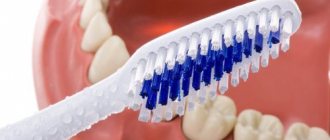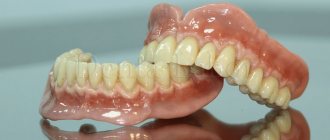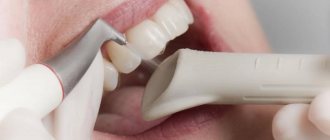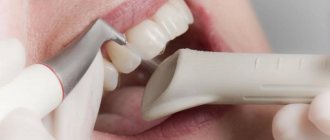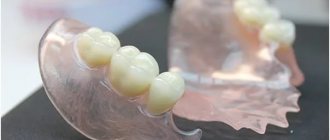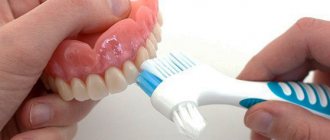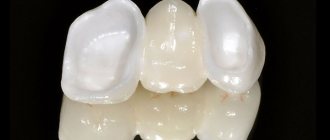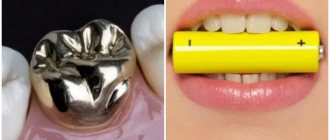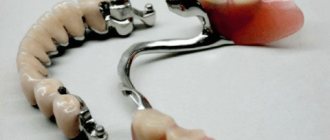From this article you will learn:
- how to care for dentures made of plastic,
- how to store dentures at night,
- cleaning dentures.
The article was written by a dentist with more than 19 years of experience.
Caring for dentures is a whole range of activities, which includes not only daily hygienic care of the denture, but also its regular disinfection, as well as compliance with the rules for its storage. In most cases, patients do not properly care for their dentures, which quickly makes them unusable.
For example, out of habit, you may begin to clean your dentures with regular toothpaste and a brush, which will lead to the appearance of small scratches on it. As a result, the surface of the denture becomes rough, which leads to the rapid deposition of plaque and tartar on it, the appearance of age spots, and the denture itself begins to smell bad. But caring for removable dentures is not so complicated - you just need to follow a few simple rules, and then your denture will serve you for a long time.
How long does it take to get used to removable dentures?
On average, 30 days. At the beginning of use, removable dentures feel like a foreign body and can cause discomfort. They can interfere with the production of sounds (diction), cause increased salivation, changes in taste and temperature sensations, and difficulty biting and chewing food. Sometimes, when applying removable dentures, the urge to vomit may occur. It is also possible that the dentures do not adhere satisfactorily, or food debris gets underneath them, or biting the cheeks, lips, or tongue. All these phenomena decrease by the end of the first week of wearing the prosthesis and disappear after 3-4 weeks. After an adaptation period, the patient already feels more comfortable with prostheses than without them.
The main condition for quickly getting used to prostheses is their constant use. The rules and recommendations below will help you shorten the adaptation period.
Nutrition
- When using a clasp design, for the first time after installation, while adaptation to the design occurs, you need to eat only soft food.
- You should not bite food with your front teeth. Chew food only with the help of the lateral teeth, distributing it evenly on the right and left jaws.
- When you get used to the prosthesis, you can gradually switch to your usual food, but nevertheless, for the successful functioning and durability of the clasp prosthesis, it is necessary to minimize or eliminate hard, sticky and viscous foods from the diet.
- When chewing hard food, the artificial tooth may break off and cause structural failure.
- You can train your chewing skills by eating fruits or vegetables cut into small pieces.
- Viscous and sticky food can stick to the denture and cause it to break.
How to quickly get used to new dentures
- Immediately after submitting the finished work in the dentist’s chair, learn how to remove and put on removable dentures yourself. At home, practice again, first in front of a mirror, then without it.
- Before applying, soak removable dentures in water or use a fixative.
- For the first one and a half to two weeks after the application of dentures, they should not be removed from the mouth, even at night. Take them out only for cleaning and oral hygiene.
- To reduce the gag reflex, try sucking the candy by placing it towards the roof of your mouth and holding it in this position with your tongue.
- Rinse your mouth often with warm water (8-10 times a day) or drink hot tea.
- Reading aloud in a calm, relaxed atmosphere for 2 hours helps to quickly restore correct pronunciation. In most patients, diction is restored quite quickly (after 5-6 days)
- For the first 2-4 days of wearing the prosthesis, try to eat soft foods and not load the prosthesis until you fully adapt to it. Try not to bite with your front teeth. Chew your food slowly and thoroughly.
- Chew food with your side teeth at the same time (left and right at once). Cut food into small pieces. Introduce more fruits and vegetables into your diet (this will allow you to switch to your usual diet earlier).
How to restore diction
To restore diction, it is recommended to speak as much as possible: read books, pronounce tongue twisters, while holding one or more sweets in your mouth (without sugar! For example, Sula with mint or sea buckthorn).
15-20 minutes, several times a day. The duration of the course is the first 1.5-2 weeks after prosthetics. Tongue twisters for restoring diction after removable prosthetics
| For your convenience, we have selected several useful tongue twisters |
| The snout pig was white-nosed, blunt-nosed; I dug up half the yard with my snout, dug, dug. |
| Karl stole Klara's advertising, and Klara stole Karl's budget. |
| In Kabardino-Balkaria, valocordin from Bulgaria. |
| The fast talker quickly said quickly, That you can’t quickly talk all the tongue twisters, but you can’t over-speak all the tongue twisters, But, having quickly spoken, he quickly said, That you can’t talk all the tongue twisters, but you can’t over-speak. |
What are the main rules when using removable dentures?
Dentures must be clean. After each meal, they should be removed from the mouth and washed thoroughly with soap and water.
Removable dentures should be protected from mechanical and chemical damage, as well as from exposure to high temperatures. If cracks or breakages appear in a removable denture, you cannot use it; you must consult a doctor for repairs.
Do not take breaks from wearing a prosthesis for more than one and a half to two weeks, because... this can lead to an initial discomfort that can make it difficult to fit the prosthesis exactly into place. As a rule, if a prosthesis is not used for more than a month, it becomes unusable and a new one needs to be made.
How to eat after installing structures
If the prosthesis is made of comfortable materials, if it suits you, then you will be able to eat well right away. Restrictions occur when little time has passed after the removal of living teeth, when you initially had gum inflammation. In such situations, pressure causes pain; you need to limit the chewing load to avoid discomfort and allow the gums to recover.
In general, during adaptation it is advisable to adhere to the following recommendations:
- give preference to soft and warm foods, exclude viscous foods,
- you need to chew carefully and thoroughly, cut food into small pieces,
- It is better to chew food on the side where the process does not cause pain,
- You should refrain from biting food with your front teeth.
After adaptation, when the prosthesis no longer causes pain, you can return to your usual diet. But you should exclude foods that are too hard, viscous, sticky, excessively hot and cold (drinks and soups should be warm, ice cream should be kept a little at room temperature).
What is prosthesis correction and when should it be done?
After applying removable dentures in the oral cavity, as a rule, pain appears in some areas underneath. This is due to the inevitable gradual subsidence (pressure) of the removable denture on the mucous membrane. This factor cannot be fully taken into account when designing these orthopedic structures, therefore, correction is necessary to eliminate unpleasant sensations. It consists of “undermining” the dentures in those areas where it presses on the oral mucosa.
The first correction must be carried out the next day after the start of using dentures. The next 3-4 corrections must be carried out over a period of one and a half to two weeks as necessary. You may need more visits to the dentist after completing your work (up to 10).
In case of severe pain, you need to remove your dentures and put them in a special container or glass of water. Before going to the doctor for correction, you must wear dentures and walk around with them for at least 3-4 hours. This will allow the doctor to see a clear imprint on the mucous membrane and correct only the place that is rubbing the gum. Bringing a denture in your pocket and pointing your finger in your mouth is useless. In removable dentures, every centimeter, and sometimes even a millimeter, of the supporting surface is of great importance. If the correction is inaccurate, the fixation of the prosthesis may be impaired. This is exactly what happens if you try to grind or file dentures yourself. After correction (adjustment) of removable dentures, you must not use them for 1 day. During this period (during the healing period of the namin), it is advisable to rinse your mouth and make baths (hold the solution in the mouth at the site of the namin) with herbal decoctions. Use a decoction of chamomile flowers, oak bark, etc. For example, take 0.5 tablespoons of dry oak bark, brew in one glass of boiling water, cool, apply the decoction 3-5 times a day. You can also use medicines, for example Kamistad gel, sold in pharmacies.
Feel free to visit your dentist for adjustments. Removable dentures, even if they are made in the most careful manner, require correction. Even if you do not experience any pain or discomfort, you should visit the dentist for an oral examination.
WARNING : Do not attempt to straighten dentures yourself with a file or any other tool. This can lead to breakage of the prosthesis and disruption of its fixation. Moreover, after such “repairs” it is no longer possible to do anything with the prostheses in the clinic. As a result, all that remains is the manufacture of new orthopedic structures.
Is it possible to whiten dentures?
If hygiene is insufficient, dentures may change their shade. But, unfortunately, it is impossible to bleach it to its original state, especially if a lot of plaque has accumulated and the coloring pigments have penetrated deep into the pores of the material. The doctor can perform polishing - the prosthesis will be smoother, its top layer will be a little ground off, so the structure will be visually lighter. At home, you can try using special whitening tablets (for example, Corega), but you should not overuse them - they can damage the prosthesis materials.
How to care for removable dentures
Proper care of them is of great importance for the period of adaptation (adaptation) and the service life of prostheses. Removable dentures require regular cleaning. The best option is to clean dentures daily after each meal under running water. The obligatory minimum is cleaning the prosthesis before going to bed. The main criterion is that the prosthesis must be as clean as on the first day. The cleaner the denture, the more comfortable you will feel it in your mouth.
When cleaning a denture with whitening toothpaste, scratches may form on it, which contributes to the rapid accumulation of plaque on the denture, because Such pastes contain abrasive substances, so for daily care you can use a weak soap solution.
Dirty removable dentures cause rapid wear and tear and inflammation in the oral cavity. If there is inflammation of the mucous membrane in places of contact with a removable denture, pain, or burning, you should immediately consult a doctor. From strong tea, coffee and smoking, removable dentures lose their appearance, turn yellow, and a brown coating appears on them. With good care, removable dentures retain their color and shine for a long time.
An indicator of good care is the absence of food and plaque on the prosthesis. To remove age spots from coffee and nicotine, etc., which may appear over time, you should consult a doctor. The dental technician will restore the necessary polish and shine.
To clean dentures, you can use special cleaning agents sold in pharmacies (President, Corega, Protefix). They also help get rid of plaque and destroy bacteria that cause bad breath. The prosthesis is placed in a glass of clean water and a tablet is lowered; the prosthesis is kept in the solution for a certain time recommended by the manufacturer.
Cleaning the prosthesis from heavy dirt –
By severe contamination we mean pronounced pigment plaque, or partially mineralized microbial plaque, or already hard tartar. Such tightly attached dental deposits can be removed from the surface of a removable denture in 2 ways. Firstly, use a special ultrasonic bath (this is not only very convenient, but will also allow you to save on purchasing effervescent tablets in the future). But there is another option, which we will discuss below.
1) Using an ultrasonic bath –
The best care for removable dentures can be achieved using an ultrasonic bath (Fig. 5). This bath allows you to ideally clean the denture from tartar, pigment plaque and odor, and also kills 100% of bacteria. In addition, you will no longer need to buy any chemicals (and spend money on it), or scrub the denture with a toothbrush.
The cost of an ultrasonic bath for cleaning dentures is only from 2500 to 3500 rubles. Such a device for cleaning dentures can also be used for contactless cleaning and disinfection of items for any other purpose, for example, baby items (pacifiers, bottles), precious metals, and other items. Of course, on the Internet you can find Chinese models for 500 rubles, but they all have low power (cleaning will be weak) and are not very reliable.
The most important criterion that will allow you to compare ultrasonic baths from different manufacturers and choose the best one is the power of the ultrasonic waves (measured in W). This indicator is usually always written in the product characteristics. Accordingly, the quality of cleaning the prosthesis will depend on the power.
2) The most powerful denture cleaner –
This option for cleaning the prosthesis can only be considered as an emergency assistance, without resorting to it too often. This method will allow you to efficiently remove all dental plaque and pigment plaque, and it is often used in hospitals to clean removable dentures in bedridden patients. Please note that this cleaning option is suitable for all types of plastic dentures (including nylon and Acry-free), but is NOT suitable for dentures with metal structural elements.
To do this, you need to purchase a descaling liquid for coffee machines. Why in coffee machines: we believe that such liquids make them better and safer, because... Coffee machines are complex, expensive devices that also contain plastic parts. And manufacturers produce anti-scale liquids for their coffee machines, guaranteeing that they will not harm either their devices or those who drink coffee. We experimented with De'Longhi EcoDecalk descaler, which, according to the instructions, is diluted with lukewarm water - 1:10.
De'Longhi EcoDecalk (500 ml) –
Those. The product is quite economical, and you can buy it cheapest on Ozon or Yandex Market (sold in 250 or 500 ml volumes). The denture can be soaked in a diluted liquid for 10-20 minutes, then rub the denture a little with a soft brush and then rinse well with running water. But if you have a thick layer of plaque or dental deposits on your denture, then you can safely leave the denture in the solution for several hours. Our experience has shown that thanks to this treatment, the denture can be cleaned even from massive plaque and dental deposits. And let us warn you once again - this option is only suitable for prostheses that do not have metal structural elements.
How to improve the fixation of removable dentures
The anatomical conditions in the oral cavity do not always allow for the creation of good fixation for removable dentures. This especially applies to prosthetics for the complete absence of teeth in the lower jaw. Under unfavorable conditions, special fixing agents in the form of creams, fixing pads, and powders are used to keep it in the mouth. They are sold under the brands “President”, “Corega”, “Protefix” in any pharmacy.
The fixing cream is applied in a thin broken line to the prosthesis. Before applying the cream, removable dentures must be dried, for example with a cotton swab. Fixing powder is used for low salivation. It is applied in a thin layer to the wet denture, after which the removable dentures can be put on. Your dentist will help you decide on the choice of fixative.
Care products
Modern means for caring for dentures are varied and more effective than the old-fashioned solutions with soda and potassium permanganate, which will do more harm than good. They are specially designed for different types of structures, therefore they are absolutely harmless.
Care products can be fixative or cleansing. The most popular of them are fixing adhesives and creams. They contribute to a reliable fit of the prosthesis and redistribution of the load during chewing. It prevents food debris from getting under them and does not rub the gums, since the glue creates an airtight cushion. At night, the structure with fixing substances must be removed, this is the condition for their use.
Fixing powder is suitable for people with weak salivation. A thin layer of powder is applied to the structure, which is pressed tightly against the gums, creating an obstacle to food particles. And strips of special canvas for fixation are necessary if a person has an abnormal jaw structure.
Another common remedy is special tablets that dissolve in water. This solution can not only clean dentures, but also whiten them. True, they do not work on persistent nicotine stains; you will need the help of a dentist who will remove them with ultrasound. This needs to be done every six months.
Rinsing, cleaning, disinfection, professional care - these are the main components of the care process. And what means are used for them will depend on the specific model of prostheses.
What to do if your prosthesis breaks?
During the use of removable dentures, a fracture of the prosthesis or its individual parts (tooth, clasp) may occur. In this case, you need to consult a dentist. If a tooth(s) on which partial removable dentures are held or supported are lost, it is possible to weld an artificial tooth to the denture in place of the lost one. Repairing a removable denture takes 2-3 days. Repairs are made without warranty.
In case of cracks, fractures, etc. Do not try to fix the denture yourself, even if urgently. Only specialists can repair the prosthesis.
Making new removable dentures takes about 1 week. The warranty period for plastic removable and clasp dentures is usually up to 1 year. During the warranty period, the prosthesis is repaired or altered free of charge. After the warranty period expires, the work is paid in full.
Can you clean dentures with toothpaste?
Cleaning of dental prosthetic structures should be done at least once. Ideally, you should do it every time after eating. As for the question of choosing toothpaste for dentures , the most important thing is that it is soft. The paste should not contain abrasives, as they cause significant damage to artificial teeth.
To do this, use the controlled abrasiveness index. Denture paste has a controlled abrasiveness from 0 to 70. If the index is more than 70, then the paste poses a danger to dental prosthetic structures.
When deciding the question +which toothpaste to clean dentures with, you must take into account that this procedure can be performed without the use of toothpaste, since its main purpose is to eliminate organic particles remaining on the teeth. In addition, instead of toothpaste, you can use a detergent that does not contain abrasives that harm artificial teeth, but does contain bactericidal components.
In what cases is it necessary to contact a dentist?
If you notice a burning sensation in the mucous membrane, severe dry mouth, skin rash and other unusual symptoms, you should contact your dentist, who, if necessary, will refer you to an allergist for allergy tests.
Once a year it is necessary to reline the removable denture. The fact is that while wearing a prosthesis, atrophy of the mucous membrane and bone tissue occurs under it. Because of this, a void appears between the prosthesis and the mucous membrane and the prosthesis does not fit tightly to the prosthetic bed. To eliminate these negative aspects, the prosthesis is relined - plastic is placed in place of the void formed due to atrophy and a tight fit of the prosthesis is restored. If relining a removable denture is done at the wrong time or not done at all, the removable denture becomes unusable.
Visit your dentist at least twice a year, consult with him about the specifics of caring for your oral cavity, and use special devices and medications recommended by him, if necessary!
How to choose a storage container
Storing dentures is a very important issue for patients who wear orthodontic appliances. Manufacturers of dental products have developed special containers. Special chests protect products from pathogenic bacteria. The material of high-quality cases is medical polypropylene. It does not deteriorate over time. Its design is such that the patient does not have to put his fingers into the solution. The device is easy to get out using the holder that is installed on the mesh.
Convenient to perform disinfection procedures. You cannot do without such a case on the road if the prosthesis needs to be transported for restoration work. It is unacceptable to shake fragile false teeth in a travel bag. They are securely fixed in a special chest. High-quality containers close tightly and have built-in mesh separators. It is important that the box is deep, then the solution will completely cover the product. It’s good if the chest has a built-in mirror so that you can put the device on while on the road. It is not advisable to purchase cases made of plastic, as it can become deformed.
The best drawers for dentures are those that follow their shape. This saves the amount of disinfectant solution to be poured. The weight of such a case will be insignificant. It will be convenient to carry with you. Many modern containers have a mesh bottom. This allows the solution to drain back into the box after the denture is removed. Therefore, there is no need to change it every time. Among modern models, the following cases stand out:
- Conventional containers that consist of one body.
- Boxes with a mesh type separator.
- Ultrasonic models that clean false teeth from plaque and food debris. The devices disinfect and sterilize orthodontic appliances.
- Illuminated drawers are suitable for patients with low vision. Additional lighting helps to remove the structure from the tank.
There is great demand for Bradex containers. Polypropylene containers from the Swiss manufacturer Curaprox are popular. Sonic Denture Cleaner products are equipped with an ultrasonic cleaning system. In a short time, the machine will clean the artificial units on its own. True, such models can only be used at home. Denton polypropylene cases are equipped with built-in lighting. The German company produces Miradent models. They are complemented by a mirror and a brush.
Necessity of processing
Sometimes microcracks form on the surface of the prosthesis, which leads to the accumulation of bacteria.
Polishing and grinding the prosthesis will help get rid of microcracks, uneven surfaces and other defects. They are safe and easy to perform procedures.
Sanding is necessary to remove excess plastic or plaster from the edges of the denture. In this way, it is possible to achieve full compliance of the product in shape and thickness with the previously modeled wax cast.
After grinding, the surface becomes slightly rough, which helps food debris stick to it and cause bacteria to multiply.
Polishing helps create a perfectly smooth surface of the denture. Thanks to this, it becomes more durable, resistant to physical and chemical influences, and acquires a beautiful aesthetic appearance. Also, after this procedure, caring for the artificial structure is greatly simplified.
Processing of the prosthesis is performed in a certain sequence:
- removing plastic residues, eliminating irregularities along the edges of the product;
- finishing of the external surface, control of base thickness;
- finishing of the distal border of the product;
- finishing the edges adjacent to the teeth;
- finishing the area near the clasp;
- finishing near the necks of artificial jaws;
- finishing the inner surface of the product (carefully eliminating minor defects with smooth, sliding movements of the devices).
Comments
I heard that dentures need to be stored in a cool place, on the forum they even advised putting them in the refrigerator, is this really true?
Alla (01/29/2020 at 15:28) Reply to comment
- Dear Alla! There is no scientific evidence that dentures keep better in the refrigerator. But a sharp change in ambient temperature, for example, cold or heat, can equally lead to deformation of the product, breakdowns and its premature failure.
Editorial staff of the portal UltraSmile.ru (02/04/2020 at 09:19) Reply to comment
Write your comment Cancel reply
What happens if there is no care
Installing a new and beautiful denture can give a person the deceptive feeling that the artificial structure will always be like this and there is no need to take special care of it. But this opinion is wrong, because the characteristics of the materials (for example, the presence of micropores on the surface) and the lack of regular cleaning and disinfection are a direct path to the appearance of age spots and the formation of tartar on the teeth. Moreover, it is impossible to remove the stone even with a special brush and paste at home. The result will be the following manifestations:
REPROSTHETICS WITH ACRYLIC PROSTHETICS - RUB 200,000.
Re-prosthetics with an acrylic bridge on a metal frame (all included) up to 12 units.
Save RUR 30,000. Call now or request a call
- decreased smile aesthetics,
- stomatitis due to the influence of microbes on the mucous membranes,
- destruction of supporting teeth: caries occurs due to cariogenic bacteria,
- risk of breakage of the prosthetic base: stone build-ups can reduce the strength properties of materials, especially elastic ones - plastics, nylon, acrylic,
- penetration of harmful microbes into the stomach and intestines: inflammatory processes occur, beneficial substances are less absorbed, and the body’s immune defense weakens.
Why do dentures sometimes need to be removed from the mouth after adaptation?
After the stage of getting used to removable appliances has passed, you can and even need to periodically remove them from your mouth and store them separately. Sometimes this needs to be done so that the mucous membrane can rest and recover.
If an allergy or rash appears, and the mouth feels dry, then the “removable jaws” should be removed from the mouth. In addition, it is necessary to visit a dentist who will determine the cause of the problem and prescribe treatment appropriate to the situation.
Acrylic dentures release monomers. Although in modern systems their content is minimal, monomers are toxic substances that can provoke the development of an allergic reaction and irritation of the mucous membrane. Therefore, they need to be removed from the mouth from time to time, and the mucous membranes should be given a break.
“The doctor explained to me how to store plastic dentures. You don't have to take them out every day. I listened to her and began to leave them overnight, which I greatly regretted. Once I woke up as if in a nightmare: something came up to my throat, blocked my breathing and really made it difficult to breathe. It was very scary. It turned out that the dentures began to shift, and it even seemed to me that they almost slipped into my throat. I don’t know if this is possible, but now I always take them off at night out of harm’s way and store them separately! I think that with pullers, such a nuisance can happen to everyone, especially if you sleep very soundly: they move and can even injure the mucous membrane. Although I personally couldn’t sleep soundly with them, they always got in the way, because... slid in my mouth."
Bekereva, review from the dental portal gidpozubam.ru
If the design contains metal elements, such as, for example, in clasp systems there are hooks for fixation on supporting teeth and a metal arch, then the situation is exactly the same. Metal in some patients can provoke the development of allergies with constant contact with the mucous membrane, causing itching and burning, swelling of the palate, tongue, and gums.
All-inclusive cleansing
The effectiveness of denture care depends on comprehensive cleansing.
The main aspect of cleaning is the hygienic condition of the prosthesis. When cleaning, special attention is paid to the surface of the structure that is adjacent to the mucous membranes. Then the prosthesis must be thoroughly washed with water and, for disinfection, it is recommended to be immersed in a special disinfection solution.
How often should a clasp denture be removed?
At least once a day, the structure must be treated in a special solution, which is sold ready-made or prepared using special pills. The structure is placed in the prepared solution for 5 - 10 minutes.
Washing with water
This method is not enough for high-quality cleansing.
Cleansing with a toothbrush
It is carried out to remove plaque and stuck food particles between artificial teeth and at the junction of parts of the structure.
Photo: Cleaning with a toothbrush
Cleaning is done using special or regular toothpaste using the same movements as natural teeth. It should be the same as at the time of its production. It is recommended to wash the structure after each meal. It is better to use the freshest boiled water for rinsing, since it does not contain harmful microbes that can get on the prosthesis.
Cleansing with antiseptic agents
This is still enough to remove bacterial plaque and food debris from the denture.
This solution protects the iron parts of the structure from corrosion.
Once a week, the structure is treated in a special bio-solution, which removes difficult-to-remove stains and food debris in hard-to-reach areas of the prosthesis.
Professional cleansing
Photo: Professional teeth cleaning
It is carried out in a dental clinic if the structure is poorly cleaned using the above methods.
As a result of professional cleaning of the structure, solid deposits are eliminated.
This rule also applies to professional cleaning of the oral cavity.
Side effects due to unsuitable whitening products
Side effects from the wrong selection of cleaning or bleaching agents can damage the prosthetic structure to such an extent that it loses its attractive appearance and functionality. Consider the dangerous consequences:
- the appearance of scratches and cracks on the product,
- the appearance of white, colored or dark spots on artificial teeth, gums, metal components,
- unpleasant taste or burning in the mouth,
- allergic reactions, stomatitis,
- displacement or breakage of clasps,
- deformation and destruction of the orthopedic structure.
“I’m already used to using cleaning tablets - it’s convenient and the results from them are noticeable. The paste didn't help much. And I soak the plastic in the solution a couple of times a week and everything is fine. I've been using it for 2 years now and it looks just like my teeth. But I also go to the dentist for professional cleaning, otherwise I can’t remove the stone with a simple brush.”
Irina P., review from gidpozubam.ru
Final finishing
Thanks to polishing the prosthesis, its surface becomes perfectly smooth, which guarantees the strength, aesthetics and cleanliness of the product.
During polishing, the prosthesis must be held with the index, middle and thumbs. First, the interdental spaces of the prosthetic structure are treated using a conical felt.
Then the entire surface of the product is polished (except for the alveolar processes and the surface facing the hard palate) using a cylindrical felt. The procedure should be performed until a completely smooth surface is formed.
During the entire process, the denture should be moistened from time to time with polishing powder diluted with water.
During treatment with brushes, it is necessary to avoid touching them with the edges of the prosthesis (against the movement of the brushes). Clasps or other metal elements are pre-polished separately.
After processing the base, these elements acquire shine thanks to a thread brush with Goya paste. Prolonged rubbing of the same area should be avoided . To avoid deformation, the product must be periodically moved by hand. It is unacceptable to press the attachments tightly against the prosthesis so that it does not melt.
At the end of the procedure, the structure must be thoroughly washed with warm soapy water using a brush, then dried completely. Polishing is performed at a faster speed than sanding. The harder the material of the product, the faster the speed.
The video shows the stages of polishing a denture.
